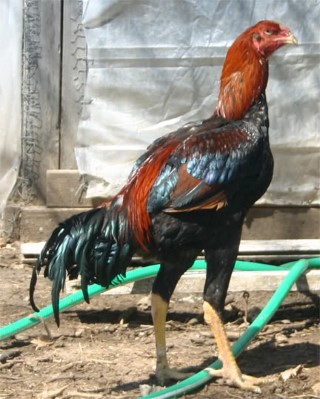Malay chickens can stand over three feet tall. Bred
originally for cockfighting, owners today keep them primarily for exhibition.
They lay one egg a week. At best an older hen may lay fifty eggs a year. Malays
have a lean, tough carcass that usually requires special cooking preparation.
Although a rangy, aggressive fowl, they lack hardiness. Malays do poorly in
confinement. Breeders have used them quite effectively for regenerating and
improving other Asian fowl.
Raised to fight, the Malay chicken displays a fierce
aggressiveness. A Malayan hen will kill chicks from other hens if they come to
close to hers. Of course, the roosters will always fight given the opportunity.
If an owner has too many Malay chickens in confinement, they will eat each
other’s' feathers. Malays make poor pets. Small scale farmers have a Malay
around just to preserve the breed or for a conversation piece. Few poultry
people choose to have a flock.
Malay chickens gain their height from a combination of long
legs and a long neck. They are slender in stature and roosters weighs nine
pounds of pure muscle. Hens weighs seven pounds. Poultry experts classify the
Malay and other fighting breeds as “Asian Hard Feathers.” Malays have glossy,
firm, and narrow feathers that fold on one another like armor close to the
body. They have little fluff or down underneath as common to other breeds.
Their feathers fail to cover the entire body leaving the throat and face naked.
Malays have a fierce and cruel looking face heightened by their overhanging
brow and sunken pearl colored eyes. Their face ends in a short but broad hooked
beak. Razor sharp spurs complete the picture of this very intimidating fighting
fowl.
Malays come from Asia and have little tolerance for cold.
Provide a warm coop for colder weather. Keep the number of Malay in your flock
low as they have low tolerance for each other especially in confinement. Malay
hens with sparse feathers have trouble covering eggs. Provide an incubator if
necessary. Separate hens with chicks. Keep roosters apart. Introduce any new
chickens into the flock slowly. Provide room for victims to escape attackers.
Malays like to aggressively dig when foraging. They need the exercise to
maintain their muscles. Provide them room for both foraging and exercise.

